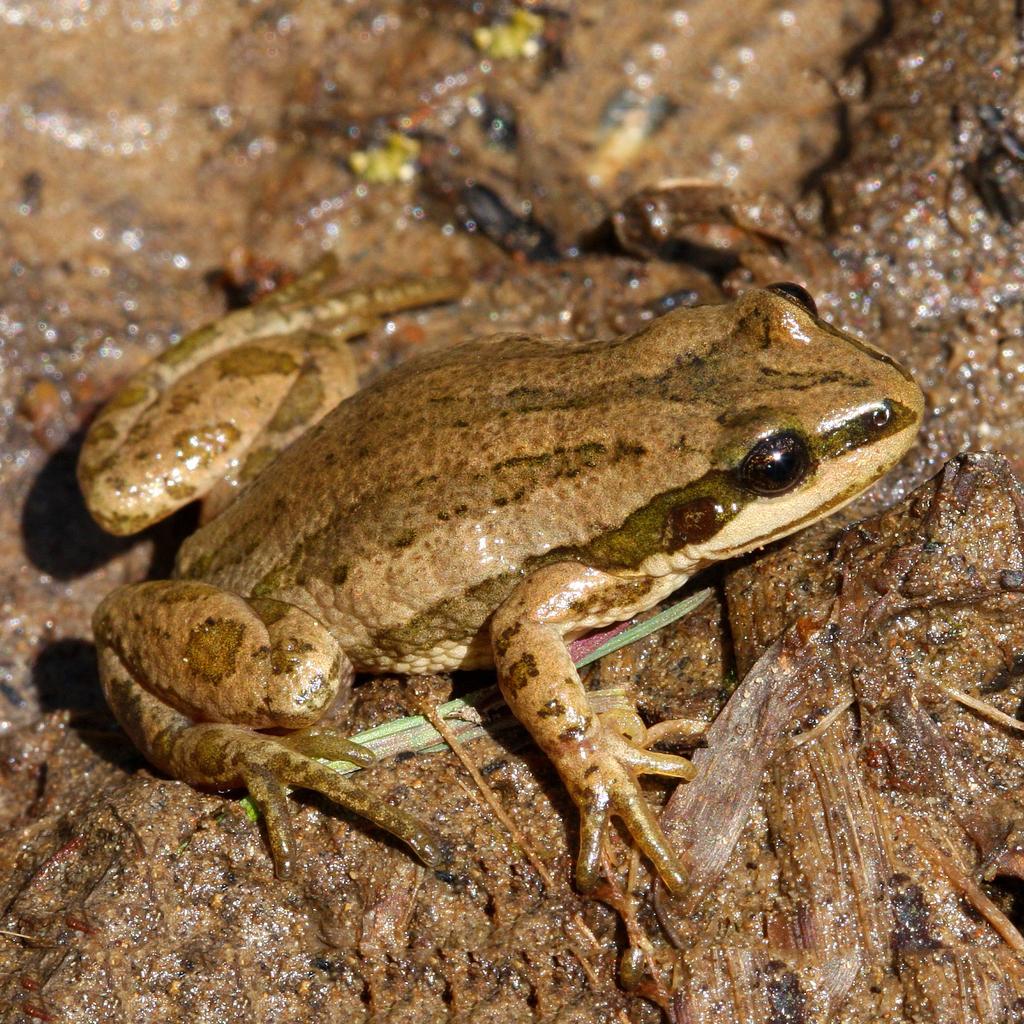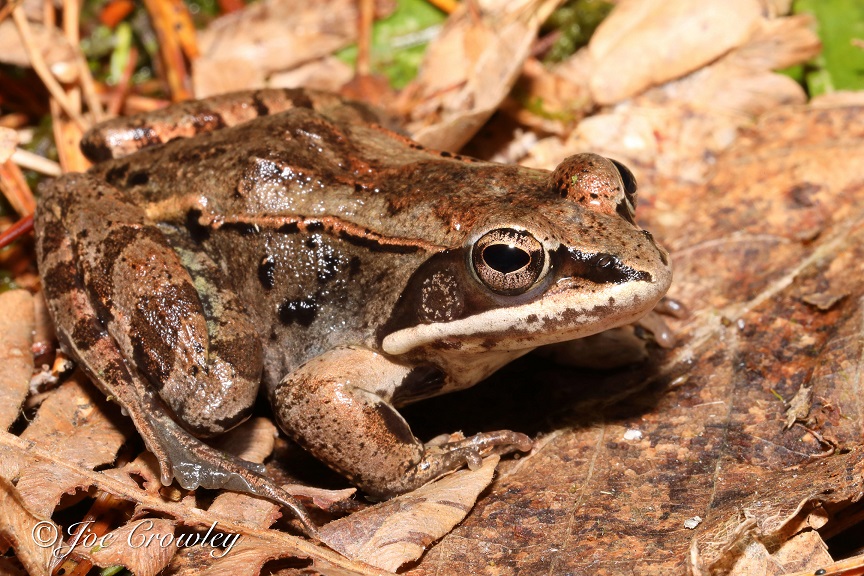Northern leopard frog
The northern leopard frog (Rana pipiens) is a small-sized frog, averaging 5-8 cm. It is either green or brown in body colour with large, dark spots, giving the frog its name. Leopard frogs have raised ridges on the sides of their back, also called dorsolateral ridges, which are lightly coloured.
There are three populations in Alberta: the plains population, who live in southeastern Alberta, the boreal population, who live in the northeasternmost part of the province, and the Rocky Mountain population, who live west of the Rockies and are a part of British Columbian populations.
Historically, northern leopard frogs have been endangered in Canada. Over the last 20 years, the Albertan provincial government has taken measures to increase the population of northern leopard frogs, particularly in the Rocky Mountains. In 2022, the Wilder Institute/Calgary Zoo (WICZ) released 1,929 frogs into the wild to help boost their numbers.
Wood frog
The wood frog is known to scientists by the name Rana sylvatica, but may also be known by the name Lithobates sylvatica. In 2006, a researcher named Darrel R. Frost wrote an article called "The Amphibian Tree of Life" where he restructured the amphibian family tree, and changed the genus of the wood frog from Rana to Lithobates. Wood frogs have very prominent dorsolateral ridges that are lighter than the body colour, which can be red or brown. They also have a dark blotch on each side of the face, behind the eyes. The pattern on the body can be different from frog to frog. In Alberta, the wood frog can be found in every corner of the province, and is distributed in every province and territory of Canada.
Columbia spotted frog
 |
| Photo by United States Fish and Wildlife Service |
The Columbia spotted frog (Rana luteiventris) has a brown body with lightly-coloured spots and dorsolateral ridges. They are found west of the Rocky Mountains of Alberta and in eastern British Columbia. Columbia spotted frogs enjoy a semi-aquatic lifestyle, meaning they can live on both land and in water, and will swim to the bottom of the nearest water body to hide when frightened. It is considered to be a true frog because it is a member of the family Ranidae.
Boreal chorus frog
 |
| Photo by J. N. Stuart |
The boreal chorus frog (Pseudacris maculata) is a type of tree frog with a green or brown coloured body, and a dark stripe running along its side and passing through the eye. It is small, with the largest size for an adult being 4 cm. It is widespread in Canada, with its distribution including Quebec, Ontario, Manitoba, Saskatchewan, Alberta, and the Northwest Territories; as well as extending into the United States. Boreal chorus frogs have a buccal sac on their chin, which they fill with air to make a call to other frogs in the area. The frogs can use their calls to announce their location to possible mates, or warn other frogs of predators in the area.
Canadian toad
The Canadian toad (Anaxyrus hemiophrys), unlike many of the frogs in Alberta, is brown or gray in colour, with black or red spots. It possesses a large bump on its head, called a "cranial crest," which sits just behind the eyes. On each hind foot, there is a claw which the Canadian toad uses to dig burrows. In Alberta, Canadian toads live mostly in the eastern region, extending into Saskatchewan and Manitoba. They will dig burrows below the frost line: a line which marks how deep the soil will freeze during the winter. Below the frost line, the soil will not freeze, and Canadian toads will hibernate until spring. They will also burrow into the soil to avoid the heat during the hottest months of summer.
Boreal or western toad
 |
| Photo by J. N. Stuart |
This toad is known by two names: the boreal toad, and the western toad (Anaxyrus boreas). Its body is green or brown and covered in bumps, and it does not have any cranial crests on its head, unlike other toads in Alberta. The boreal toad possesses large parotid glands on the back of its cheeks, which create spit and special toxins called "bufotoxins."
In Alberta, boreal toads are found in the western central region, with the majority of its range in British Columbia and the western United States.
Great Plains toad
 |
| Photo by Drew R. Davis |
The Great Plains toad (Anaxyrus cognatus) is green or brown in colour, with lighter-coloured skin on its belly. It is also covered in dark splotches, and has a cranial crest on the back of each eye, forming the shape of an L. Great Plains toads are found in southeastern Alberta, and southwestern Saskatchewan, with most of their distribution in the United States. They are nocturnal, which means they are most active at night and will spend their days burrowed underground, hiding from predators and the heat of the sun.
Plains spadefoot toad
The Plains spadefoot toad (Spea bombifrons) is not a member of Bufonidae, the family of true toads, unlike the other three toads found in Alberta. It has a brown or gray body covered in bumps, a large cranial crest between the eyes, and a vertical pupil. They also have a keratin-covered horned "spade" on each hind foot which it uses to dig burrows. In Alberta, the Plains spadefoot toad is found in the southern region of the province, and extends all the way across the United States, into Texas. Like the Great Plains toad, Plains spadefoot toads will burrow into the soil during the day to escape the heat, and burrow below the frost line in the winter to hibernate.
Frogs in an urban wildlife context
Alberta runs the Alberta Volunteer Amphibian Monitoring Program (AVAMP), which provides information about the frogs and salamanders that make Alberta home. Through AVAMP, Albertans can submit online their observations of amphibians in the wild. Observations aren't just seeing the animal, they also include hearing the noises that one makes, referred to as calls. They also provide tips for attracting amphibians to your yard.
Encouraging amphibians to move in
Frogs and salamanders prefer quiet, cool, and wet environments. A good first step is to pick a secluded area that is unlikely to be disturbed by pets or children. Allow any shrubs, greenery, or grass to overgrow and become "wild," the frogs and salamanders will hide in the leaf litter during the day and enjoy the moisture from the plants. Amphibians are semi-aquatic, so if there is a water feature or garden without fish, they will be very happy.
For more information, visit https://www.ab-conservation.com/avamp/overview/.
Sources
Frost, R. Darrel et al. 2006. The amphibian tree of life. Bulletin of the American Museum of Natural History, 2006(297):1-291 (2006). https://doi.org/10.1206/0003-0090(2006)297[0001:TATOL]2.0.CO;2
Image sources linked on image




No comments:
Post a Comment